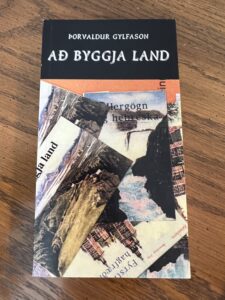To Build a Nation

This small book contains the manuscript of my three television programs that were shown on Icelandic State Television (RÚV) in November 1998, and again in December 1998, when the book also appeared in print in Icelandic. The programs were shown on Faeroese State Television 2005. They were reissued on DVD in 2011 and rebroadcast on Hringbraut, a private TV channel, in 2018.
These programs deal with the history of economic thought in Iceland, during the previous century and our own, by means of a continuing narrative focused on three individuals, Jón Sigurðsson, Einar Benediktsson, and Halldór Laxness.
The first programme is entitled The Trail-blazer, and presents a portrait of the leader of the Icelandic independence struggle, Jón Sigurðsson, known as “President Jón”, because he was president of the Copenhagen chapter of the Icelandic Literature Society. He is portrayed as a dedicated proponent of free trade and foreign investment in Iceland: as a champion of liberal economics and Iceland’s first economist. On questions of domestic politics, he was faced with strong opposition, with the result that his leadership and ideas were rejected time and again.
The title of the second program, which deals with the poet Einar Benediktsson, is Captain Courageous. The ideas he advanced for the nation’s economic affairs and progress were a direct continuation of the struggle for freedom led by Jón Sigurðsson, but his views did not win out in the stormy political combat which characterised the early decades of this century. Iceland chose to follow a course quite different from that plotted by Jón Sigurðsson and Einar Benediktsson.
The Critic is the title of the third program. It describes how the author Halldór Laxness responded to the restrictive economic policies followed by the authorities during the 1940s. His arguments for free trade, a more rational agricultural policy, and other economic reforms are described in order to shed light on the economic and social reality in Iceland up until our own times.
A variety of cultural and historical materials are woven into the narrative, including, for instance, details of the personal lives and circumstances of the three men. All of the materials are the result of my own investigations, based on a variety of older and newer sources. Some of the material has already appeared in print. All of the material on Einar Benediktsson, however, is new.
The music accompanying the first program is by Richard Wagner, a contemporary of Jón Sigurðsson. It includes passages from three of his operas: Die Walküre, Die Meistersinger von Nürnberg, and Tannhäuser. Die Meistersinger was performed on the stage of the Royal Theatre in Copenhagen in 1872, only four years after its world premiere in Munich. Tannhäuser, which premiered in Germany during the first years Jón Sigurðsson spent in Copenhagen, was shown in Copenhagen in 1875, four years before his death. It is not known whether Jón saw these works on stage.
In the second program all the music is by Jón Leifs. Einar Benediktsson knew Jón Leifs personally. Icelandic folk melodies arranged by Jón were premiered at Einar’s home, Þrúðvangur, in Reykjavík in 1925, and the collection included the composer’s own original music to Einar’s poem “Rís þú, unga Íslandsmerki” (Fly high, young Iceland’s symbol). The tune also appears in Iceland Overture by Jón Leifs dating from 1926.
The music in the third program is by Johann Sebastian Bach, the favorite composer of Halldór Laxness. It includes, for example, preludes and fugues from the Das wohltemperierte Klavier and from Die Kunst der Fuge. Halldór Laxness himself played Bach’s keyboard music at home. “When I am asked what single book I would choose to take with me if I had to spend the rest of my life on a desert island, I always answer: Das wohltemperierte Klavier” (Skáldatími, p. 89).
The book is available with or without a videotape containing the three episodes, which take about 40 minutes each. Actor Pálmi Gestsson plays the roles of the three men. Artist Vignir Jóhannsson designed the sets. Karl R. Lilliendahl handled cinematography and Jón Egill Bergþórsson directed the filming. The author of the script, producer, and narrator is Professor Thorvaldur Gylfason.
The book manuscript is available in an English translation by Keneva Kunz. A few copies of the videotape (VHS) with English subtitles are also available for interested foreign viewers. And now, as said above, the film is available commercially on DVD.